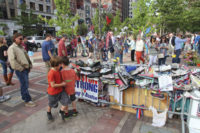How the University of Texas at Austin Secures 100,000-Fan Football Games

With more than 100,000 fans regularly attending games at the Darrell K Royal (DKR)-Texas Memorial Stadium, the University of Texas at Austin relies on regular training, close public-private partnerships and constant communication to secure events.
Photo courtesy of the University of Texas at Austin
“For us, a game day activity is no small matter,” says James (Jimmy) Johnson, Assistant Vice President for Campus Safety at the University of Texas at Austin.
No kidding – Longhorn football games regularly sell out, hosting more than 100,000 fans in the Darrel K Royal (DKR)-Texas Memorial Stadium, not counting the small army of vendors, staff, security personnel and law enforcement that keep operations running smoothly. In addition to the high-profile target that a large event like this becomes, UT Austin personnel are also addressing severe weather challenges (from tornadoes to severe thunderstorms to excessive heat), the fact that the stadium is part of an urban campus in the middle of a thriving metropolitan city, and the variable soft target of thousands of fans tailgating around the stadium and walking to the game.
“We look at this from a multi-hazard risk assessment protocol,” says Johnson. “For us, the potential for adverse outcomes is high, so we look at threats, vulnerabilities and consequences associated with these incidents and occurrences. We identify, analyze and assess what the risk is and how we either accept, avoid, transfer or try to control it based on an acceptable level of risk and an acceptable cost.”
For the last 10 years, UT Austin has taken an increasingly businesslike approach to game day security, using the national framework and incident command structure for events and campus incidents. “We practice like we play, so if an event were to really happen we have the right people in the right places with the right objectives in mind,” Johnson adds. “In addition, we’re trying to do things that are fan-friendly while adding an extra layer of security.”
The university’s athletic branch also hired David Allison, formerly of the U.S. Secret Service, to fill its newly created position of Safety & Security Manager, Facilities and Events Operations.
“When I got here and started assessing where the vulnerabilities were, one thing I noted is the large crowds coming to and from events become a soft target,” Allison says. “We look and see what may be going on at other venues, and normally when events start occurring in Europe, that’s the preemptive posture that it could happen here as well.
“We started seeing events where individuals are using vehicles as weapons against large crowds in Germany, Paris and London, so we started putting plans in place with water barriers and vehicles that were owned by the athletic department, whereby we created different chokepoints so nobody could obtain enough velocity (to attack) without warning so law enforcement is able to respond. So you have these vehicles there to deter, deflect or defeat someone using their car, whether it’s accidental or intentional, to harm the crowd coming from the game.”
The university is using these barriers as opportunities, as well. Johnson says that once the water barriers were deployed, the university or police department partners could begin to use them to place signage or maps. The university is also looking at sponsorship opportunities for these barriers, so a car dealership could display a number of new pickup trucks, for example, stationed at key chokepoints as an additional barrier.
This is all a part of the five concentric circles of security inside and around DKR Stadium. While some venues, such as for Olympics or NFL stadiums, might have the luxury of designing a secure campus, universities are often restricted by existing terrain, buildings and city planning, and they have to work around what’s already in place, Allison says.
The security perimeter stretches six blocks in each direction around the stadium, where some law enforcement officers and traffic direction control are in place. Within four blocks of the stadium, more roadblocks and wayfinding areas are placed, along with law enforcement and parking assistants. Within a block of the stadium, more officers are stationed, and on the four corners of “Stadium Block,” there are 32 gates into DKR, and there are officers visible outside, at the gates and inside the gates. Officers and security officials are also strategically placed along the concourses and securing the field.
“We’re establishing checkpoints and perimeters, and it has to do with the terrain and what threats we’re trying to address,” says Peter Scheets, MSCJ, Assistant Chief of Police, The University of Texas at Austin University Police. “From the fan’s perspective, they’re moving through these concentric circles of security as they’re going toward and into the stadium, but it’s not intrusive; it’s just part of the game day experience.”
To keep fans’ security experience as smooth and unobtrusive as possible, communication and training are key. According to Johnson, the University’s communications responsibilities on game day are four-fold:
- Provide guidance to fans during emergency situations
- Provide information to peers, supervisors and subordinates working events
- Demonstrate a familiarization with the stadium facility to all people working on game day
- Understand what we need to do in the event of an emergency, shelter-in-place or lockdown
The university uses the Greater Austin County public safety system, radio channels, ribbon boards, text messages, Jumbotron announcements and more to provide information that’s pertinent and timely to fans, usher staff, game managers and supervisors. With 100,000 fans connecting to broadband throughout the game on their smartphones, the security and public safety teams strive to avoid relying on cellular service during the game.
For upcoming initiatives, UT Austin will do cross-messaging at other sporting events, so if there’s information that football fans need to know, it will be displayed during the baseball or basketball season, Allison says. Security news and FAQs can also be included with ticketing packets and emails, added to the Texas Sports website, and disseminated throughout the Longhorn Foundation.
In 2017, UT Austin decided to implement a Clear Bag Policy – similar to the one used by the NFL – to its sporting events. However, a lot of research, coordination and communication was required to do it right. According to Allison, UT Austin officials visited other facilities that had implemented Clear Bag Policies, discussed the topic at (NCS)4 conferences, and researched challenges and successes across clubs and sports. The research “helped us transition a bit smoother than if we had gone in blind,” Allison says. “We saw another venue handing out free one-gallon freezer bags to their fans, and we were able to obtain those and have parking attendants give them to visitors who weren’t accustomed to the policy so that they wouldn’t have to make unnecessary trips back home or to their car or leaving their $500 purse at the front gate.”
The communication moves both ways, too. Fans can utilize a text messaging service to send alerts to staff during events. If they notice a problem, such as broken toilets in a section of the stadium to unruly fans to ill or hurt patrons, they can text the information and receive a response or a request for more information while resources are deployed, Johnson says.
The personnel aspect of game day security and operations involves that “small army” of around 3,500 people and many different agencies. Within the emergency operations center (EOC) on game day, around 26 agencies participate, including Campus Safety, the National Weather Service, the Austin Police Department and Fire Department, Austin School District, Austin County EMS, Austin County Sheriff’s Office, the FBI Joint Terrorism Task Force, St. David’s Hospital, representatives from the City of Austin, Transportation Services, and Environmental Health and Safety, to name a few. At the end of the 2017 season, the university finished a massive technology overhaul of their EOC, adding in new capabilities such as real-time weather monitoring to video enhancement and surveillance capabilities to video conference interfaces to streamline emergency communications and situational awareness.
On the Tuesday of each game week, the university holds a general operations meeting with around 125 people in attendance, representing all of the participating agencies. This meeting provides a comprehensive look at everything, from kickoff times to when the last bus departs and everything in between, Johnson says.
Allison will also brief police and security partners about any VIPs attending the events, what security details or specific contingency plans they may bring with them, and any special events that might be happening on the field during the game.
Three hours before the game, there is also a police briefing to evaluate any emerging threats and get everyone on the same page. The University Police will have compiled an operations plan, coordinating all the local law enforcement partners involved in the game, Scheets says. All of the security components are put in place four hours before each game, and there are also elements that go into place the day before.
Training is a continuous cycle. Supervisors undergo extensive training and drills during the off-season, including practicing how to evacuate their section during an emergency.
“We practice and update our shelter and evacuation plans annually,” says Johnson. “It’s no simple task to shelter-in-place with 100,000 people, but the design of the stadium is such that our concourses will hold folks if we have inclement weather, and we practice that every summer with the folks who work those areas. If you work in section 111 as a supervisor, you look at your multi-card (an informational guide attached to staff lanyards) and it tells you the 15 things you need to do to get the 2,000 people out of the stands in front of you. We put a lot of time and effort into that.”
Staff are also given “just in time” training right before the event commences, as well as a briefing and security update from Allison.
“We meet with event staff before every game to reiterate the importance of what they’re doing in terms of the safety and security of visitors – to be professional, to be aware of their surroundings, to say something if they see something,” says Allison. “All of that is refreshed every game by myself or other individuals we bring in, like the fire marshal to discuss keeping egress areas clear or the police chief to remind them about watching for unaccompanied packages around the gate.”
“Every game is an opportunity to practice and rehearse,” Scheets says. “At the end of each event we look back and conduct after-action reviews to see what areas we can improve in. Every time we have an event, we come out better on the other side.”
But on top of the planning, the technology and the training, one major factor that enables security at Longhorn football games is the buy-in and support from the University of Texas at Austin leadership.
“The leadership here, with the University of Texas Police Department, Campus Safety, Emergency Management, the academic leadership, the Athletics Director and his senior staff… they’ve all been very receptive to what this group of people have had to say,” says Allison. “They feel like the safety of all our stakeholders, from students to fans to donors, are our responsibility. They hold the safety and security of the University of Texas family in the highest regard, so on top of the personnel and the technology, it’s that buy-in that helps to support us.”
Looking for a reprint of this article?
From high-res PDFs to custom plaques, order your copy today!





